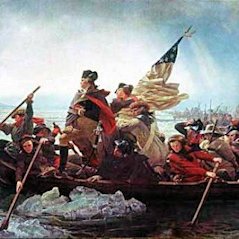
|
Some Common Myths Thought to be True - Myth 156
Myth 156: American History Painting of Washington Crossing the
Delaware River - An American Icon
German-born Emanuel Gottlieb Leutze grew up in America, then
returned to Germany as an adult, where he conceived of the idea for this
painting during the Revolutions of 1848. He used American
tourists and art students as models and assistants, among them Worthington
Whittredge and Andreas Achenbach. Leutze finished the first painting in 1850.
The flag depicted is the original flag of the United States (the "Stars and
Stripes"), the design of which did not exist at the time of Washington's
crossing. The flag's design was specified in the June 14, 1777, Flag Resolution
of the Second Continental Congress, and flew for the first time on September 3,
1777 - well after Washington's crossing in 1776. The historically accurate flag
would have been the Grand Union Flag, officially hoisted by Washington himself
on January 1, 1776, at Cambridge, Massachusetts, as the standard of the
Continental Army and the first national flag.
|
|
Artistic concerns motivated further deviations from historical (and physical)
accuracy. For example, the boat (of the wrong model) looks too small to carry
all occupants and stay afloat, but this emphasizes the struggle of the rowing
soldiers.
There are phantom light sources besides the upcoming sun, as can be
seen on the face of the front rower and shadows on the water, to add depth. The
crossing took place in the dead of night, so there ought to have been little
natural light, but this would have made for a very different painting.
The river is modeled after the Rhine, where ice tends to form in jagged chunks
as pictured, not in broad sheets as is more common on the Delaware. (However,
it is speculated that the Delaware River really was frozen over as depicted
because of the Little Ice Age that was occurring at the time.)
Also, the Delaware at what is now called Washington Crossing is far narrower
than the river depicted in the painting. It was also raining during the
crossing.
Next, the men did not bring horses or field guns across the river in
the boats, but instead had them transported by ferries. Finally, Washington's
stance, obviously intended to depict him in a heroic fashion, would have been
very hard to maintain in the stormy conditions of the crossing. Considering
that he is standing in a rowboat, such a stance would have risked capsizing the
boat. However, historian David Hackett Fischer has argued that everyone would
have been standing up to avoid the icy water in the bottom of the boat (the
actual boats used have higher sides).
|
